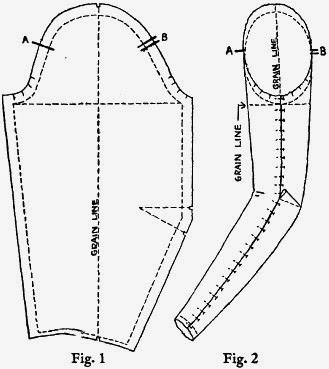My most popular blog entry is Tutorial: Reduce/Remove Sleeve Cap Ease. Excessive ease in set-in sleeves continues to be a source of frustration for many. Still, there are those that continue to insist that sleeve cap ease is necessary in order for a sleeve to fit over the curve of your shoulder. Another well meaning sewist claimed my tutorial only worked for children's clothing (my specialty) because children are smaller, but adults definitely need ease.
Kathleen has written a now classic blog entry, Sleeve Cap Ease is Bogus (including a sequel). She even did a series on how to draft an armhole and sleeve correctly so that no ease is needed (partially gated). It would be worth your time to go back and reread those blog entries.
This idea that ease is needed for proper fit is interesting. Unfortunately, it is a false concept. A sleeve should not fit over the curve of a shoulder. Instead, the sleeve should hang straight down from the shoulder. The shoulder seam needs to extend long enough that it reaches to the widest part or tip of the shoulder. In the picture below you can see the shape of both the shoulder and armhole. This draft will allow the sleeve to hang from the shoulder.
Kathleen goes into greater detail about this in her blog entries. If you draft a sleeve as instructed by many pattern making manuals with the recommended 1-2 inches of ease, you will not be able to get beautiful looking sleeves like the ones found being worn by the actors of His Girl Friday. Notice the placement of the armhole seams.
Instead, you will get a sleeve that looks something like this:
 |
| Photo courtesy of Kelly Hogaboom and is licensed under the Creative Commons Attribution-Share Alike 2.0 Generic license. |
Sleeve caps with ease amount to lazy pattern making, or at the very least pattern making without knowing better.
Children are really not much different when it comes to fit and pattern design. They do have fewer overall curves, so in many ways pattern making and fit are simpler. What curves they do have though, are smaller. Sewing a set-in sleeve in an infant sized bodice is in many ways more difficult. There is less length to work with and tighter curves. If ease is included it is just enough to allow the operator to get around that smaller circumference easier. The amount of ease is very small (1/4 to 1/2 inch) and is entirely dependent on the fabric. In many cases, it is not needed at all because the differential of a machine can be adjusted.
I can understand if this seems unbelievable. It certainly goes against the grain of conventional sewist wisdom. The best way to know, is to try it for yourself. Try using a pattern with sleeve cap ease and one without. Which sleeve is easier to sew in? Which looks better? At the end of the day, you choose which sleeve you prefer to work with.




Very interesting, Esther. I am just starting out as a home sewer (or restarting as I learnt to sew growing up but haven't done it for a while). As far as I can tell, all Bit 4 home sewing patterns apart from traditional shirt styles have sleeve cap ease. I'd love to try one without (and with the anatomical sleeve draft). Hopefully this will become more common in indie designs. Till then I'll refer to your tutorial. Thank you!
ReplyDeleteThe matching striped jacket sleeves in the blog you are referring to is actually only proving the ease on the sleeves. Have in mind that sleeve curve is cut on a biased. If you don’t have ease you will not be able to match the stripes. And another thing is that you have to know how to cut the fabric if you want the stripes to match. Cutting process is a key moment. Just my opinion.
ReplyDelete